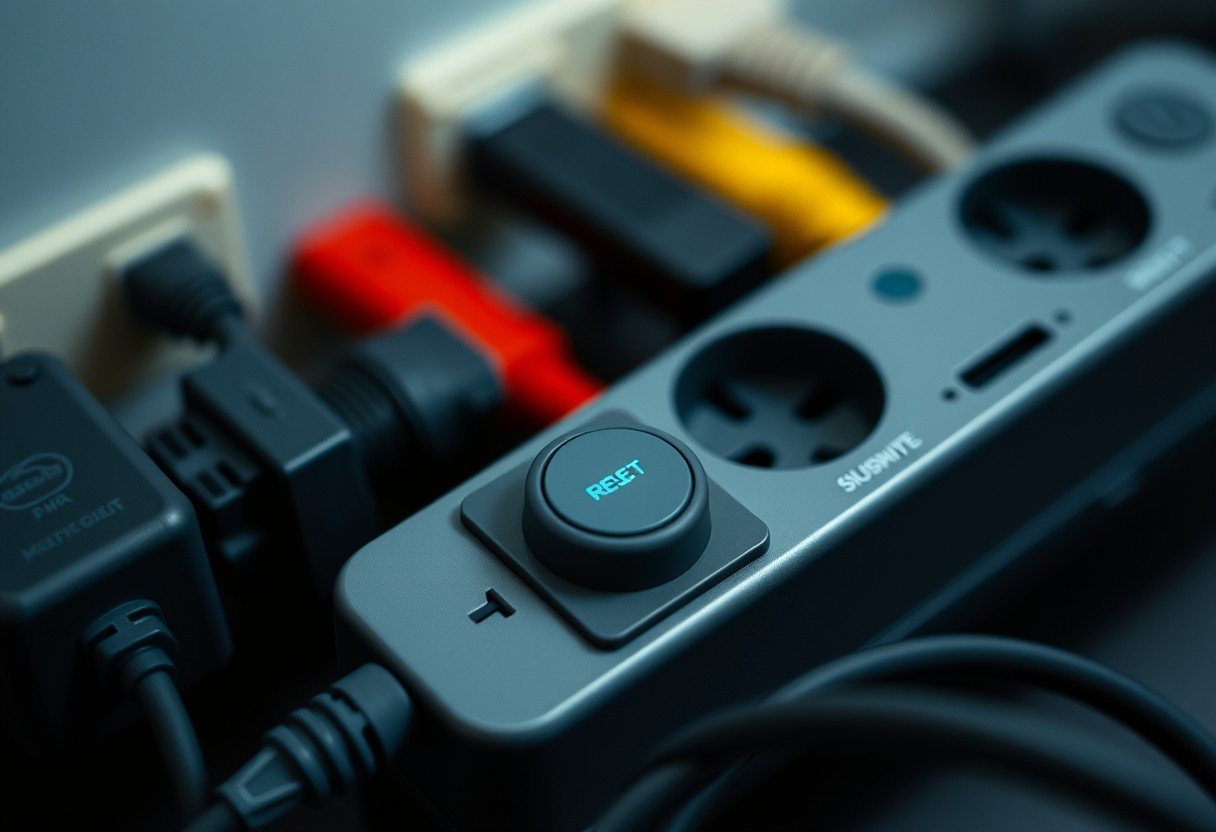That small button on your power strip is more than just a switch; it’s a vital safety feature designed to protect your valuable electronics. When a power strip is overloaded with too many devices, this built-in circuit breaker trips, cutting off electricity to prevent overheating, damage, and even potential fires. Understanding how this reset button works is the first step toward a safer and more efficient home or office electrical setup.
What Exactly is the Reset Button on a Power Strip?
The reset button on your power strip is essentially a small, reusable fuse known as a circuit breaker. Its primary job is to monitor the amount of electrical current flowing through the strip to the connected devices.
Every power strip has a maximum amount of electricity it can safely handle, which is measured in amperes (amps). If the devices you plug in start drawing more power than this limit, an overload occurs. This overload can cause the wires inside the strip to heat up dangerously.
This is where the reset button comes into play, acting as your first line of defense. It automatically detects the excess current and “trips,” which breaks the electrical circuit and instantly stops the flow of power. This action prevents the power strip from overheating and protects your expensive gadgets from being fried by the electrical fault.
How Does the Reset Button Protect Your Electronics?
The mechanism behind the reset button is both simple and incredibly effective. Inside the power strip, a bimetallic strip or an electromagnetic switch is connected to the circuit. When the current exceeds the safe level, this internal component reacts to the change.
In most cases, the excess current generates heat, causing a bimetallic strip to bend and physically trip the switch, cutting the power. The reset button pops out, serving as a visual indicator that the protective feature has been activated. Pressing it back in re-engages the circuit, but only after you have addressed the cause of the overload.
By interrupting the power flow during an overload or short circuit, the reset button prevents permanent damage to your devices. Without this feature, the excess current could destroy sensitive electronic components in your computer, television, or other appliances, leading to costly repairs or replacements.
Common Reasons Your Power Strip Keeps Tripping
If you find yourself constantly resetting your power strip, it’s a clear signal that something is wrong. Ignoring this warning can lead to safety hazards. The most common cause is simply plugging in too many high-power devices at once.
Appliances that generate heat, like space heaters, hair dryers, or toasters, draw a significant amount of power. Connecting several of these to a single power strip is a recipe for an overload. A faulty appliance with a short circuit can also cause the breaker to trip repeatedly.
Here are a few common culprits:
- Overloading the strip: Connecting devices that collectively exceed the strip’s amperage rating.
- Using high-wattage appliances: Items like microwaves, coffee makers, and power tools should ideally be plugged directly into a wall outlet.
- A faulty device: An electrical short in one of the connected devices can cause the strip to trip.
A frequently tripping power strip is not a sign that the strip is bad, but rather a warning that your setup is unsafe.
Reset Button vs. Surge Protector: What’s the Difference?
Many people mistakenly believe the reset button protects against power surges from events like lightning strikes, but that’s not its primary function. That job belongs to a feature called surge protection. While many power strips include both, they serve two very different purposes.
The reset button handles overloads, which are internal issues caused by too much power being drawn through the strip. A surge protector, on the other hand, defends against external events where a sudden, brief spike in voltage comes from the outside power line.
This table breaks down the key differences:
| Feature | Protects Against | How It Works |
|---|---|---|
| Reset Button (Circuit Breaker) | Current Overloads & Short Circuits | Physically disconnects the circuit when too much power is drawn. |
| Surge Protection | Voltage Spikes & Surges | Diverts excess voltage away from connected devices to a ground wire. |
For complete protection, it’s best to use a power strip that offers both a reset button for overload protection and a surge protector, which is usually indicated by a rating in “joules.”
When Should You Replace Your Power Strip?
Power strips don’t last forever. Their protective components can wear out over time, especially after handling multiple overloads or surges. It’s crucial to know the signs of a failing power strip to keep your home and devices safe.
If the reset button no longer stays in place after being pressed, or if it trips with even a small load, the internal mechanism is likely worn out. Any physical damage, such as a cracked casing, frayed cord, or discoloration, is an immediate red flag.
Pay close attention to any unusual signs, such as a burning smell, buzzing sounds, or the strip feeling warm to the touch. If you notice any of these issues, you should stop using the power strip immediately and replace it. As a general rule, many experts recommend replacing your power strips every 3-5 years, depending on their usage and quality.
Frequently Asked Questions
Why does my power strip’s reset button keep popping out?
A reset button that frequently pops out is a sign of a persistent overload. This means you are either plugging in too many devices or one of the connected appliances is faulty and drawing too much power. Unplug some devices, especially high-wattage ones, to solve the issue.
Is it safe to keep resetting a power strip?
While resetting it once or twice is fine, repeatedly doing so without addressing the root cause is dangerous. Constant tripping wears out the circuit breaker and indicates an unsafe electrical load, which increases the risk of a fire. You must figure out why it’s tripping.
Do all power strips have a reset button?
No, not all power strips have a reset button. Cheaper, more basic models may only function as extension cords with multiple outlets and offer no overload protection. For safety, it is highly recommended to choose a power strip that includes a circuit breaker with a reset button.
What is the difference between a reset button and an on/off switch?
An on/off switch simply controls the flow of power manually, allowing you to turn all connected devices on or off at once. A reset button is a safety feature that automatically trips to cut power during an overload and must be manually pressed to restore the circuit.
Can a power strip’s reset button wear out?
Yes, the internal mechanism of the circuit breaker can wear out over time, especially if it trips frequently. If the button feels loose, won’t stay depressed, or trips too easily, the power strip is no longer providing reliable protection and should be replaced.







Leave a Comment